Veratridine Induces Vasorelaxation in Mouse Cecocolic Mesenteric Arteries
Abstract
1. Introduction
2. Results
2.1. VTD Induces Vasorelaxation in CAs and MCAs
2.2. VTD-Induced Vasorelaxation in CAs Is Mediated by the NO-Pathway
2.3. NCX Inhibition Partially Abolished VTD-Induced Vasorelaxation in CAs
2.4. VTD Has No Effects on Intracellular Ca2+ in ECs
2.5. NCX1 Contributes to ACh-Induced Ca2+ Responses in ECs
2.6. Thapsigargin and Chelerythrine Reduce ACh-Induced Ca2+ Responses in ECs
3. Discussion
4. Conclusions
5. Materials and Methods
5.1. Chemicals and Reagents
5.2. Ethical Statement, Animal Care, and Conditioning
5.3. Wire Myography
5.4. Cell Culture
5.5. Quantitative Real-Time Polymerase Chain Reaction
5.6. Immunohistochemistry
5.7. Western Blotting
5.8. Fluorescence Assays
5.9. Statistical Analysis
Supplementary Materials
Author Contributions
Funding
Institutional Review Board Statement
Informed Consent Statement
Data Availability Statement
Acknowledgments
Conflicts of Interest
Correction Statement
Abbreviations
| ACh | acetylcholine |
| AP | atropine |
| AUC | area under curve |
| CA | cecocolic artery |
| [Ca2+]i | intracellular Ca2+ concentration |
| EC | endothelial cell |
| ER | endoplasmic reticulum |
| FOMA | first-order mesenteric artery |
| IP3 | inositol 1,4,5 triphosphate |
| L-NNA | N(ω)-nitro-L-arginine |
| MA | mesenteric artery |
| MCA | middle cecolic artery |
| MS1 | Mile Sven 1 murine |
| M3-mAChR | muscarinic receptor subtype 3 |
| [Na+]i | intracellular Na+ concentration |
| NaV channel | voltage-gated Na+ channel |
| NE | norepinephrine |
| Phe | phenylephrine |
| PZ | prazosin |
| TTX | tetrodotoxin |
| TTX-R | resistant to tetrodotoxin |
| TTX-S | sensitive to tetrodotoxin |
| VSMC | vascular smooth muscle cell |
| VTD | veratridine |
References
- Krayer, O.; Acheson, G.H. The Pharmacology of the Veratrum Alkaloids. Physiol. Rev. 1946, 26, 383–446. [Google Scholar] [CrossRef] [PubMed]
- Ulbricht, W. Effects of Veratridine on Sodium Currents and Fluxes. In Reviews of Physiology Biochemistry and Pharmacology, Volume 133; Springer: Berlin/Heidelberg, Germany, 1998; pp. 1–54. ISBN 978-3-540-63945-9. [Google Scholar]
- Craig, R.A.; Garrison, C.E.; Nguyen, P.T.; Yarov-Yarovoy, V.; Du Bois, J. Veratridine: A Janus-Faced Modulator of Voltage-Gated Sodium Ion Channels. ACS Chem. Neurosci. 2020, 11, 418–426. [Google Scholar] [CrossRef] [PubMed]
- Mattei, C.; Legros, C. The Voltage-Gated Sodium Channel: A Major Target of Marine Neurotoxins. Toxicon 2014, 91, 84–95. [Google Scholar] [CrossRef]
- Réthoré, L.; Park, J.; Montnach, J.; Nicolas, S.; Khoury, J.; Le Seac’h, E.; Mabrouk, K.; De Pomyers, H.; Tricoire-Leignel, H.; Mattei, C.; et al. Pharmacological Dissection of the Crosstalk between NaV and CaV Channels in GH3b6 Cells. Int. J. Mol. Sci. 2022, 23, 827. [Google Scholar] [CrossRef] [PubMed]
- Mcdonough, J.H.; Jaax, N.K.; Crowley, R.A.; Mays, M.Z.; Modrow, H.E. Atropine and/or Diazepam Therapy Protects against Soman-Induced Neural and Cardiac Pathology. Toxicol. Sci. 1989, 13, 256–276. [Google Scholar] [CrossRef]
- Grobosch, T.; Binscheck, T.; Martens, F.; Lampe, D. Accidental Intoxication with Veratrum Album. J. Anal. Toxicol. 2008, 32, 768–773. [Google Scholar] [CrossRef]
- Moser, M. Evolution of the Treatment of Hypertension From the 1940s to JNC V. Am. J. Hypertens. 1997, 10, 2S–8S. [Google Scholar] [CrossRef]
- Meilman, E.; Krayer, O. Clinical Studies on Veratrum Alkaloids: I. The Action of Protoveratrine and Veratridine in Hypertension. Circulation 1950, 1, 204–213. [Google Scholar] [CrossRef]
- Uribe, L.A.; Leonardo, S.; Nielsen, T.T.; Steinmann, C.; Campàs, M.; Fragoso, A. Supramolecular Complexes of Plant Neurotoxin Veratridine with Cyclodextrins and Their Antidote-like Effect on Neuro-2a Cell Viability. Pharmaceutics 2022, 14, 598. [Google Scholar] [CrossRef]
- Andrikopoulos, P.; Fraser, S.P.; Patterson, L.; Ahmad, Z.; Burcu, H.; Ottaviani, D.; Diss, J.K.J.; Box, C.; Eccles, S.A.; Djamgoz, M.B.A. Angiogenic Functions of Voltage-Gated Na+ Channels in Human Endothelial Cells: Modulation of Vascular Endothelial Growth Factor (VEGF) Signaling. J. Biol. Chem. 2011, 286, 16846–16860. [Google Scholar] [CrossRef]
- Ho, W.-S.V.; Davis, A.J.; Chadha, P.S.; Greenwood, I.A. Effective Contractile Response to Voltage-Gated Na+ Channels Revealed by a Channel Activator. Am. J. Physiol. Cell Physiol. 2013, 304, C739–C747. [Google Scholar] [CrossRef] [PubMed]
- Fort, A.; Cordaillat, M.; Thollon, C.; Salazar, G.; Mechaly, I.; Villeneuve, N.; Vilaine, J.-P.; Richard, S.; Virsolvy, A. New Insights in the Contribution of Voltage-Gated NaV Channels to Rat Aorta Contraction. PLoS ONE 2009, 4, e7360. [Google Scholar] [CrossRef] [PubMed]
- Rice, F.L.; Albrecht, P.J.; Wymer, J.P.; Black, J.A.; Merkies, I.S.; Faber, C.G.; Waxman, S.G. Sodium Channel NaV1.7 in Vascular Myocytes, Endothelium, and Innervating Axons in Human Skin. Mol. Pain 2015, 11, 26. [Google Scholar] [CrossRef] [PubMed]
- Shinjoh, M.; Nakaki, T.; Otsuka, Y.; Sasakawa, N.; Kato, R. Vascular Smooth Muscle Contraction Induced by Na+ Channel Activators, Veratridine and Batrachotoxin. Eur. J. Pharmacol. 1991, 205, 199–202. [Google Scholar] [CrossRef]
- Bocquet, A.; Sablayrolles, S.; Vacher, B.; Le Grand, B. F 15845, a New Blocker of the Persistent Sodium Current Prevents Consequences of Hypoxia in Rat Femoral Artery. Br. J. Pharmacol. 2010, 161, 405–415. [Google Scholar] [CrossRef]
- Virsolvy, A.; Farah, C.; Pertuit, N.; Kong, L.; Lacampagne, A.; Reboul, C.; Aimond, F.; Richard, S. Antagonism of NaV Channels and α1-Adrenergic Receptors Contributes to Vascular Smooth Muscle Effects of Ranolazine. Sci. Rep. 2015, 5, 17969. [Google Scholar] [CrossRef]
- Figueroa, X.F.; Chen, C.-C.; Campbell, K.P.; Damon, D.N.; Day, K.H.; Ramos, S.; Duling, B.R. Are Voltage-Dependent Ion Channels Involved in the Endothelial Cell Control of Vasomotor Tone? Am. J. Physiol. Heart Circ. Physiol. 2007, 293, H1371–H1383. [Google Scholar] [CrossRef]
- Kratholm, N.M.; Jensen, P.S.; Kringelholt, S.; Simonsen, U.; Bek, T. Activation of Veratridine Sensitive Sodium Channels, but Not Electrical Field Stimulation, Dilates Porcine Retinal Arterioles with Preserved Perivascular Tissue. Curr. Eye Res. 2017, 42, 1497–1502. [Google Scholar] [CrossRef]
- Aalkjaer, C.; Nilsson, H.; De Mey, J. Sympathetic and Sensory-Motor Nerves in Peripheral Small Arteries. Physiol. Rev. 2021, 101, 495–544. [Google Scholar] [CrossRef]
- Westcott, E.B.; Segal, S.S. Perivascular Innervation: A Multiplicity of Roles in Vasomotor Control and Myoendothelial Signaling. Microcirculation 2013, 20, 217–238. [Google Scholar] [CrossRef]
- Tangsucharit, P.; Takatori, S.; Sun, P.; Zamami, Y.; Goda, M.; Pakdeechote, P.; Takayama, F.; Kawasaki, H. Do Cholinergic Nerves Innervating Rat Mesenteric Arteries Regulate Vascular Tone? Am. J. Physiol. Regul. Integr. Comp. Physiol. 2012, 303, R1147–R1156. [Google Scholar] [CrossRef] [PubMed]
- Lillo, M.A.; Gaete, P.S.; Puebla, M.; Ardiles, N.M.; Poblete, I.; Becerra, A.; Simon, F.; Figueroa, X.F. Critical Contribution of Na+-Ca2+ Exchanger to the Ca2+-Mediated Vasodilation Activated in Endothelial Cells of Resistance Arteries. FASEB J. 2018, 32, 2137–2147. [Google Scholar] [CrossRef] [PubMed]
- Teubl, M.; Groschner, K.; Kohlwein, S.D.; Mayer, B.; Schmidt, K. Na+/Ca2+ Exchange Facilitates Ca2+-Dependent Activation of Endothelial Nitric-Oxide Synthase. J. Biol. Chem. 1999, 274, 29529–29535. [Google Scholar] [CrossRef]
- Schneider, J.-C.; El Kebir, D.; Chéreau, C.; Mercier, J.-C.; Dall’Ava-Santucci, J.; Dinh-Xuan, A.T. Involvement of Na+/Ca2+ Exchanger in Endothelial NO Production and Endothelium-Dependent Relaxation. Am. J. Physiol. Heart Circ. Physiol. 2002, 283, H837–H844. [Google Scholar] [CrossRef]
- Iwamoto, T.; Kita, S.; Uehara, A.; Imanaga, I.; Matsuda, T.; Baba, A.; Katsuragi, T. Molecular Determinants of Na+/Ca2+ Exchange (NCX1) Inhibition by SEA0400*. J. Biol. Chem. 2004, 279, 7544–7553. [Google Scholar] [CrossRef] [PubMed]
- Khananshvili, D. Structure-Based Function and Regulation of NCX Variants: Updates and Challenges. Int. J. Mol. Sci. 2022, 24, 61. [Google Scholar] [CrossRef] [PubMed]
- Fekete, Á.; Franklin, L.; Ikemoto, T.; Rózsa, B.; Lendvai, B.; Sylvester Vizi, E.; Zelles, T. Mechanism of the Persistent Sodium Current Activator Veratridine-evoked Ca2+ Elevation: Implication for Epilepsy. J. Neurochem. 2009, 111, 745–756. [Google Scholar] [CrossRef]
- Park, J.; Proux, C.; Ehanno, W.; Réthoré, L.; Vessières, E.; Bourreau, J.; Favre, J.; Kauffenstein, G.; Mattei, C.; Tricoire-Leignel, H.; et al. Tetrodotoxin Decreases the Contractility of Mesenteric Arteries, Revealing the Contribution of Voltage-Gated Na+ Channels in Vascular Tone Regulation. Mar. Drugs 2023, 21, 196. [Google Scholar] [CrossRef]
- Verkhratsky, A.; Trebak, M.; Perocchi, F.; Khananshvili, D.; Sekler, I. Crosslink between Calcium and Sodium Signalling. Exp. Physiol. 2018, 103, 157–169. [Google Scholar] [CrossRef]
- Wang, X.; van Breemen, C. Multiple Mechanisms of Activating Ca2+ Entry in Freshly Isolated Rabbit Aortic Endothelial Cells. J. Vasc. Res. 1997, 34, 196–207. [Google Scholar] [CrossRef]
- Fukao, M.; Hattori, Y.; Kanno, M.; Sakuma, I.; Kitabatake, A. Sources of Ca2+ in Relation to Generation of Acetylcholine-induced Endothelium-dependent Hyperpolarization in Rat Mesenteric Artery. Br. J. Pharmacol. 1997, 120, 1328–1334. [Google Scholar] [CrossRef] [PubMed]
- Ghisdal, P.; Morel, N. Cellular Target of Voltage and Calcium-dependent K+ Channel Blockers Involved in EDHF-mediated Responses in Rat Superior Mesenteric Artery. Br. J. Pharmacol. 2001, 134, 1021–1028. [Google Scholar] [CrossRef] [PubMed]
- Lytton, J. Na+/Ca2+ Exchangers: Three Mammalian Gene Families Control Ca2+ Transport. Biochem. J. 2007, 406, 365–382. [Google Scholar] [CrossRef] [PubMed]
- Annunziato, L.; Pignataro, G.; Di Renzo, G.F. Pharmacology of Brain Na+/Ca2+ Exchanger: From Molecular Biology to Therapeutic Perspectives. Pharmacol. Rev. 2004, 56, 633–654. [Google Scholar] [CrossRef]
- Ringvold, H.C.; Khalil, R.A. Protein Kinase C as Regulator of Vascular Smooth Muscle Function and Potential Target in Vascular Disorders. Adv. Pharmacol. 2017, 78, 203–301. [Google Scholar] [CrossRef]
- Virsolvy, A.; Fort, A.; Erceau, L.; Charrabi, A.; Hayot, M.; Aimond, F.; Richard, S. Hypoxic Conditions Promote Rhythmic Contractile Oscillations Mediated by Voltage-Gated Sodium Channels Activation in Human Arteries. Int. J. Mol. Sci. 2021, 22, 2570. [Google Scholar] [CrossRef] [PubMed]
- Yokomizo, A.; Takatori, S.; Hashikawa-Hobara, N.; Goda, M.; Kawasaki, H. Characterization of Perivascular Nerve Distribution in Rat Mesenteric Small Arteries. Biol. Pharm. Bull. 2015, 38, 1757–1764. [Google Scholar] [CrossRef]
- Kawasaki, H.; Takatori, S.; Zamami, Y.; Koyama, T.; Goda, M.; Hirai, K.; Tangsucharit, P.; Jin, X.; Hobara, N.; Kitamura, Y. Paracrine Control of Mesenteric Perivascular Axo-Axonal Interaction. Acta Physiol. 2011, 203, 3–11. [Google Scholar] [CrossRef]
- Fujiwara, H.; Hashikawa-Hobara, N.; Wake, Y.; Takatori, S.; Goda, M.; Higuchi, H.; Zamami, Y.; Tangsucharit, P.; Kawasaki, H. Neurogenic Vascular Responses in Male Mouse Mesenteric Vascular Beds. J. Pharmacol. Sci. 2012, 119, 260–270. [Google Scholar] [CrossRef]
- Dudzinski, D.; Michel, T. Life History of eNOS: Partners and Pathways. Cardiovasc. Res. 2007, 75, 247–260. [Google Scholar] [CrossRef]
- Saternos, H.C.; Almarghalani, D.A.; Gibson, H.M.; Meqdad, M.A.; Antypas, R.B.; Lingireddy, A.; AbouAlaiwi, W.A. Distribution and Function of the Muscarinic Receptor Subtypes in the Cardiovascular System. Physiol. Genom. 2018, 50, 1–9. [Google Scholar] [CrossRef] [PubMed]
- Bondarenko, A. Sodium-Calcium Exchanger Contributes to Membrane Hyperpolarization of Intact Endothelial Cells from Rat Aorta during Acetylcholine Stimulation: Sodium-Calcium Exchanger in Endothelial Cells. Br. J. Pharmacol. 2004, 143, 9–18. [Google Scholar] [CrossRef] [PubMed]
- Moccia, F.; Berra-Romani, R.; Baruffi, S.; Spaggiari, S.; Signorelli, S.; Castelli, L.; Magistretti, J.; Taglietti, V.; Tanzi, F. Ca2+ Uptake by the Endoplasmic Reticulum Ca2+-ATPase in Rat Microvascular Endothelial Cells. Biochem. J. 2002, 364, 235–244. [Google Scholar] [CrossRef]
- Girardin, N.C.; Antigny, F.; Frieden, M. Electrophysiological Characterization of Store-Operated and Agonist-Induced Ca2+ Entry Pathways in Endothelial Cells. Pflügers Arch. Eur. J. Physiol. 2010, 460, 109–120. [Google Scholar] [CrossRef]
- Wess, J.; Eglen, R.M.; Gautam, D. Muscarinic Acetylcholine Receptors: Mutant Mice Provide New Insights for Drug Development. Nat. Rev. Drug Discov. 2007, 6, 721–733. [Google Scholar] [CrossRef] [PubMed]
- Darby, W.G.; Potocnik, S.; Ramachandran, R.; Hollenberg, M.D.; Woodman, O.L.; McIntyre, P. Shear Stress Sensitizes TRPV4 in Endothelium-Dependent Vasodilatation. Pharmacol. Res. 2018, 133, 152–159. [Google Scholar] [CrossRef]
- Yao, X.; Garland, C.J. Recent Developments in Vascular Endothelial Cell Transient Receptor Potential Channels. Circ. Res. 2005, 97, 853–863. [Google Scholar] [CrossRef]
- Mulvany, M.J.; Halpern, W. Contractile Properties of Small Arterial Resistance Vessels in Spontaneously Hypertensive and Normotensive Rats. Circ. Res. 1977, 41, 19–26. [Google Scholar] [CrossRef]
- Vessieres, E.; Guihot, A.-L.; Grimaud, L.; Rivron, J.; Arnal, J.-F.; Loufrani, L.; Henrion, D. Estrogens and the Angiotensin II Type 2 Receptor Control Flow-Mediated Outward Remodeling in the Female Mouse Mesenteric Artery. J. Vasc. Res. 2021, 58, 16–26. [Google Scholar] [CrossRef]
- Morrison, T.B.; Weis, J.J.; Wittwer, C.T. Quantification of Low-Copy Transcripts by Continuous SYBR Green I Monitoring during Amplification. Biotechniques 1998, 24, 954–958, 960, 962. [Google Scholar]
- Lee, C.; Kim, J.; Shin, S.G.; Hwang, S. Absolute and Relative QPCR Quantification of Plasmid Copy Number in Escherichia Coli. J. Biotechnol. 2006, 123, 273–280. [Google Scholar] [CrossRef] [PubMed]
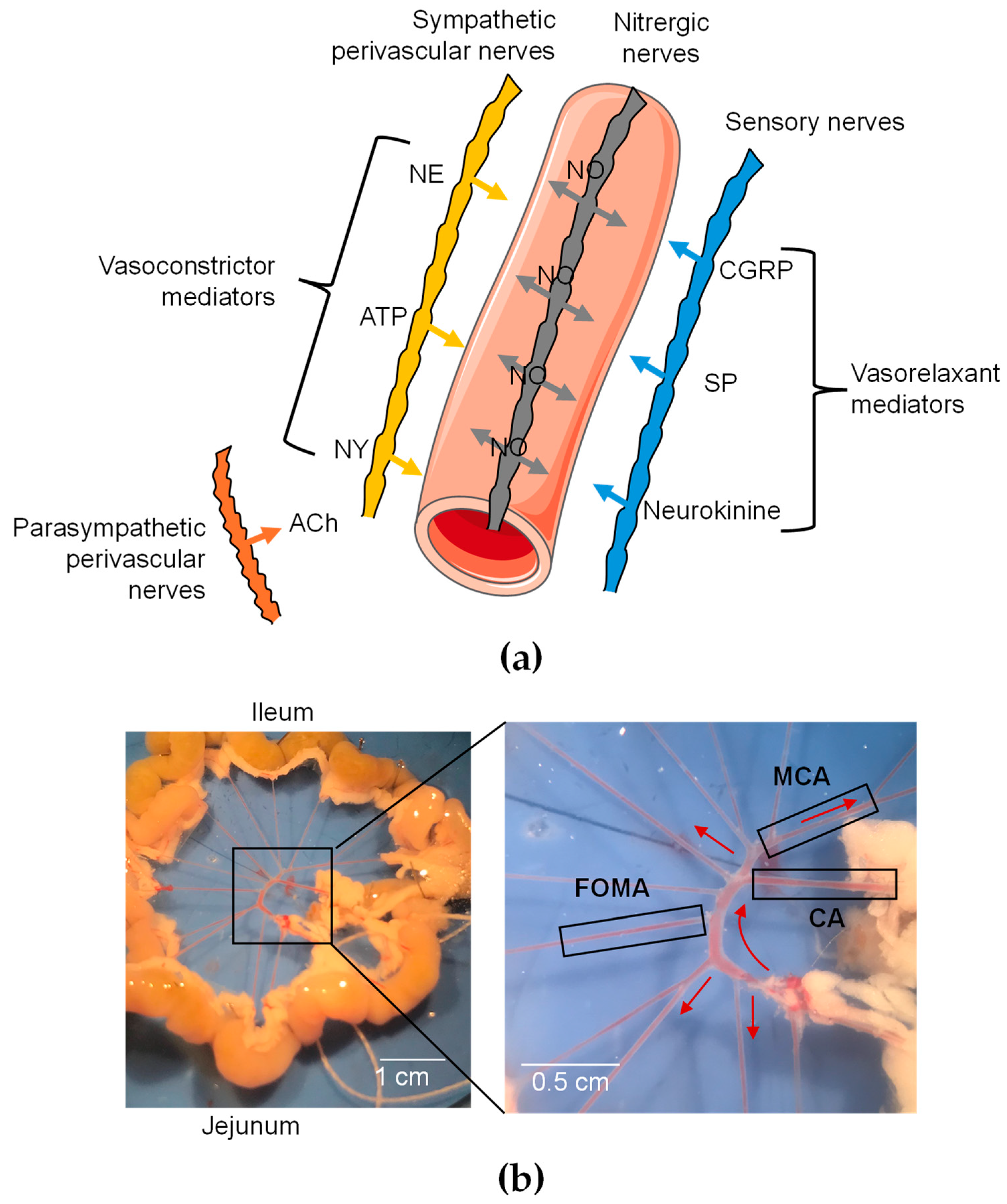
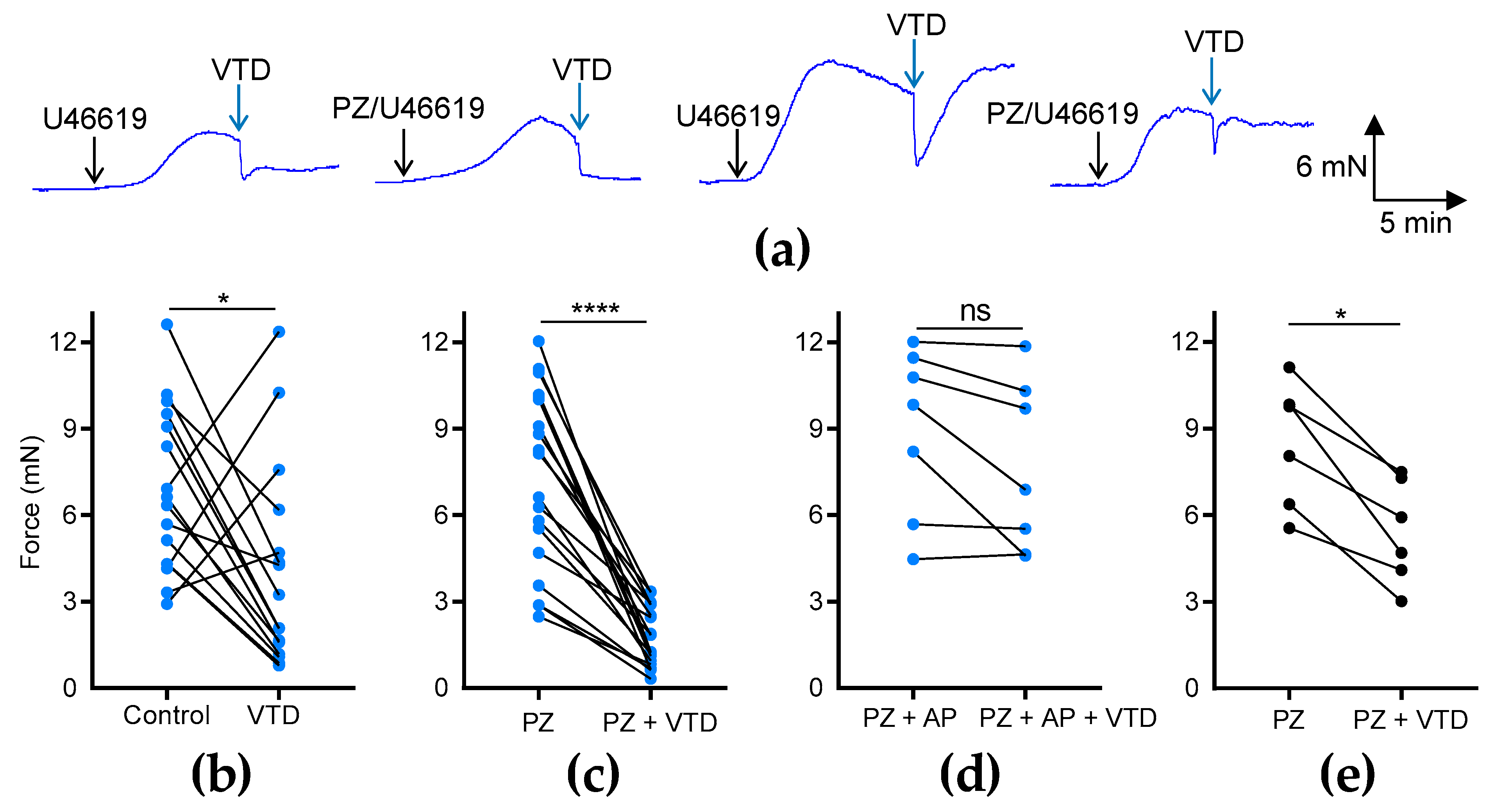
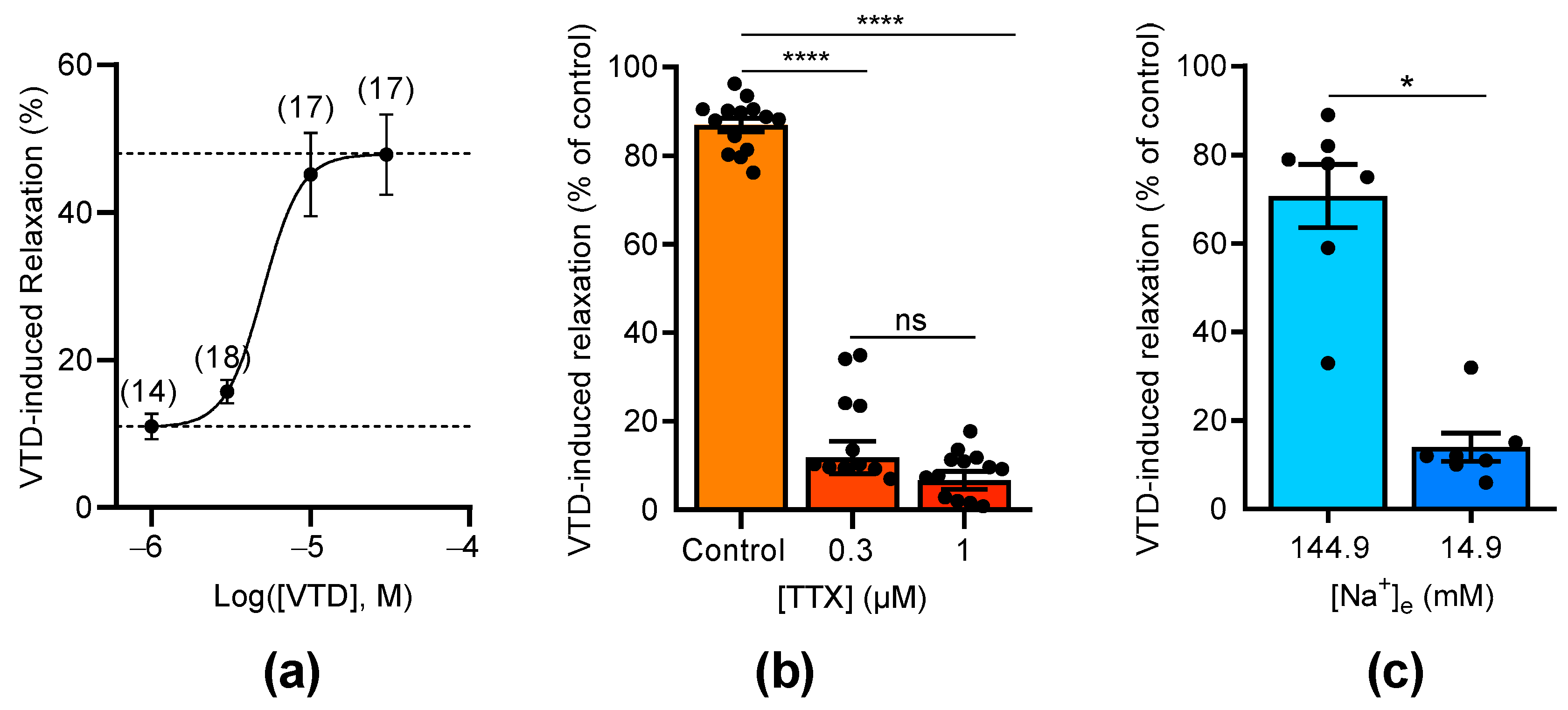
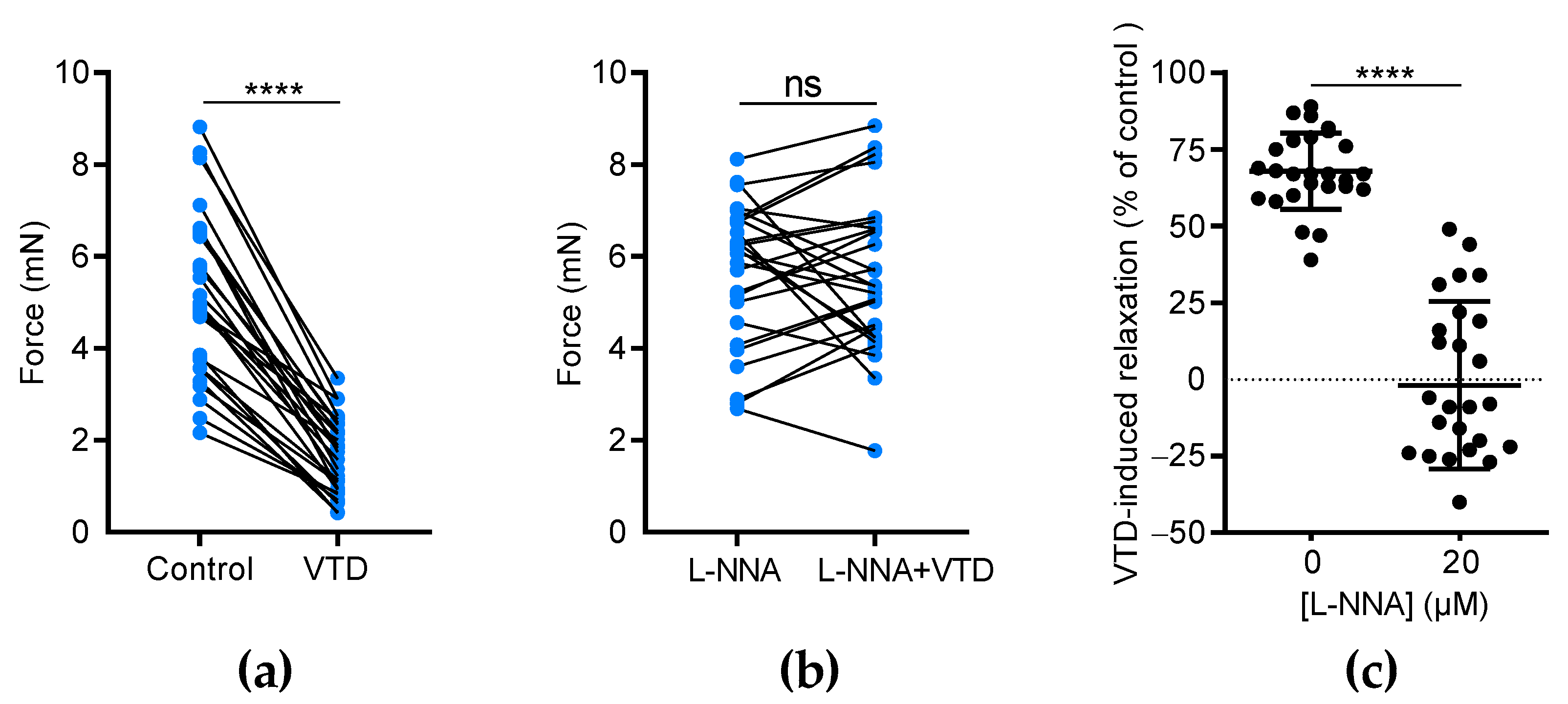

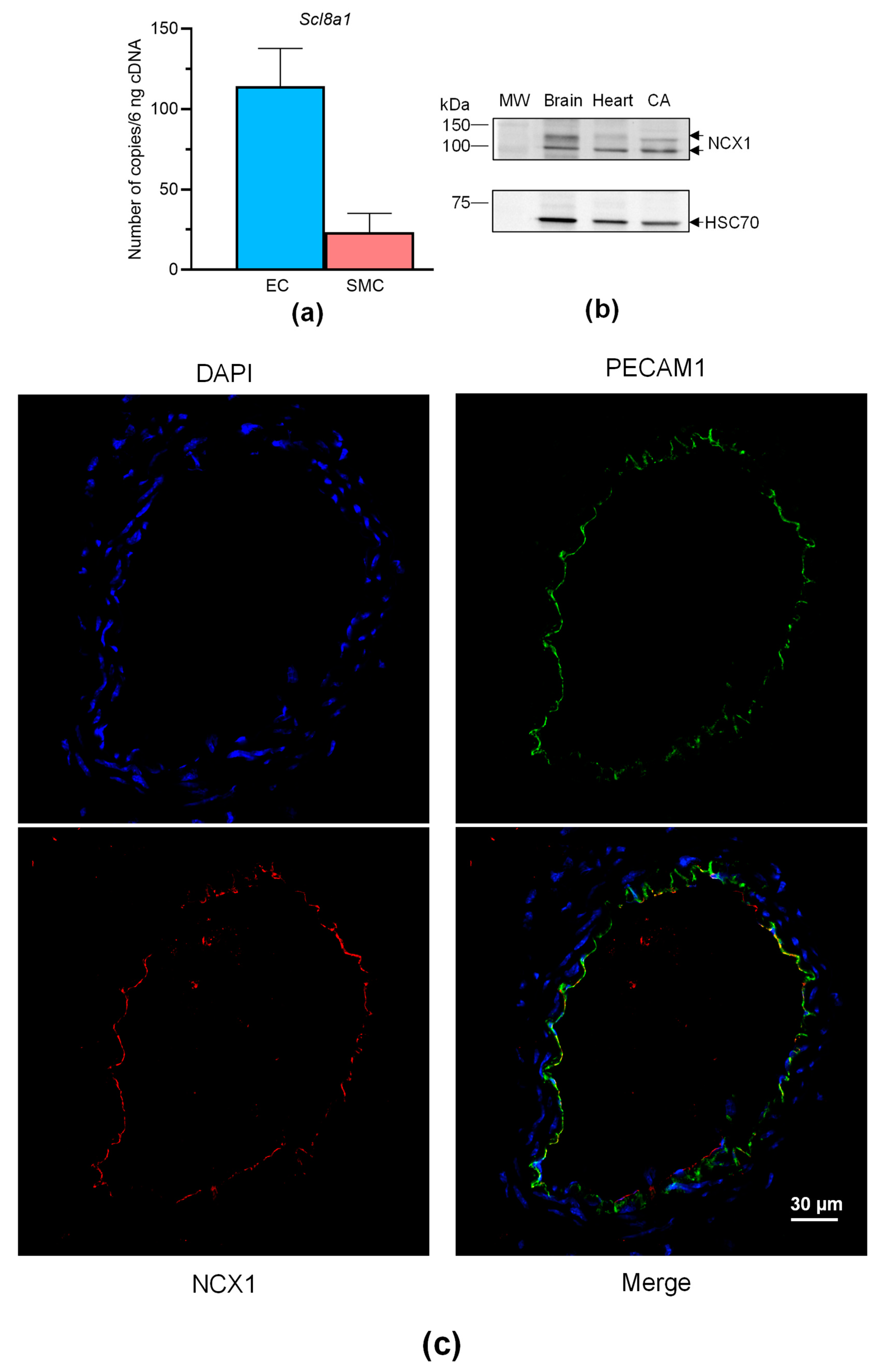


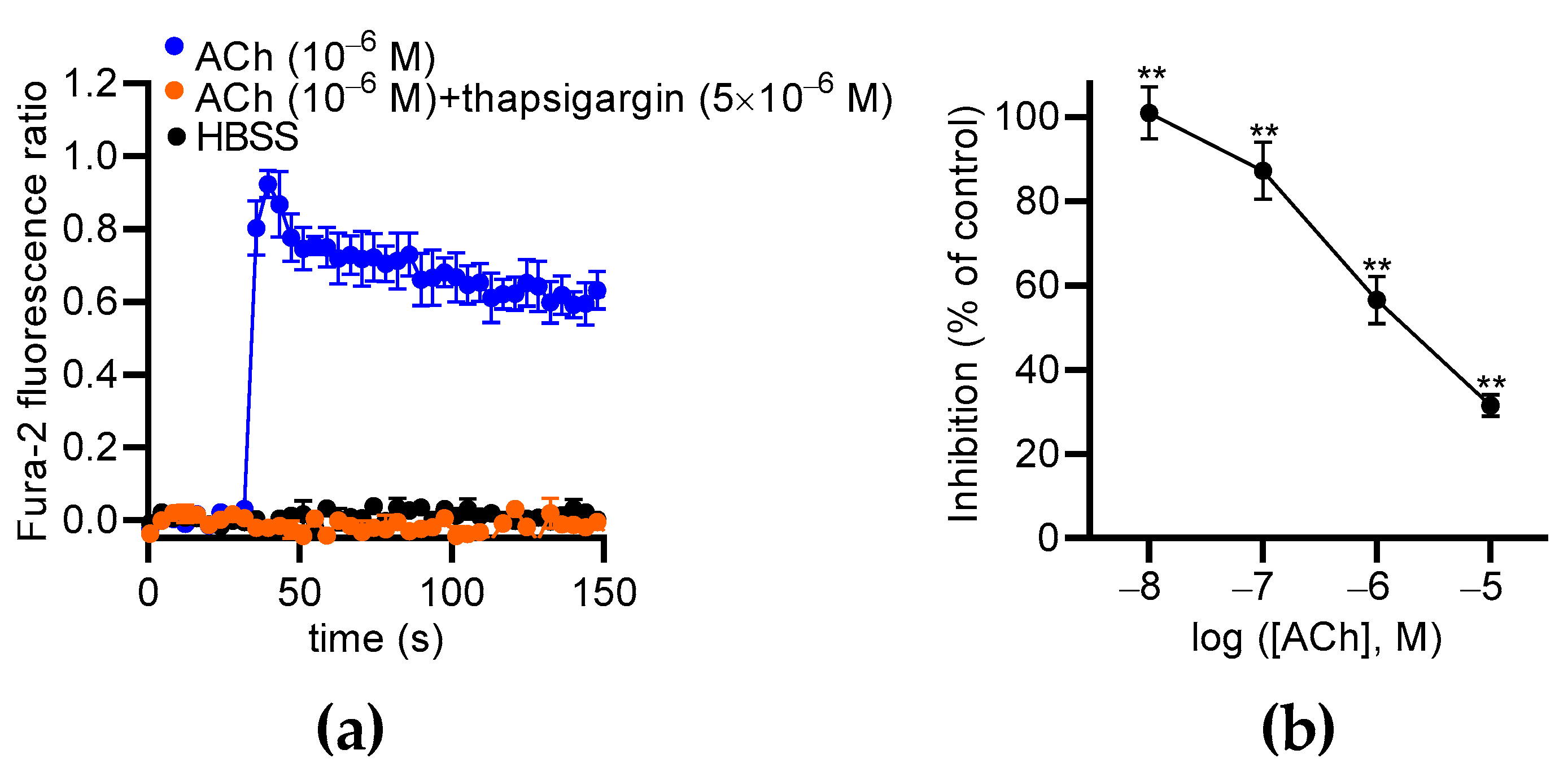
| Gene Name | Genbank Accession Number | Protein Name | Forward Primer (5′−3′) | Reverse Primer (5′−3′) |
|---|---|---|---|---|
| Scn1a | NM_018733.2 | NaV1.1 | ttgcaaggggcttctgttta | aggtccacaaactccgtcac |
| Scn2a | NM_001099298.2 | NaV1.2 | gggttgcatatggtttccaa | cccaaggcatttgcagtta |
| Scn3a | NM_018732.3 | NaV1.3 | tcctcagtagtggtgctttgg | gatgtaagtgaagactttgtcagca |
| Scn4a | NM_133199.2 | NaV1.4 | gaaaaccatcacggtcatcc | tccgagagctttttcacagac |
| Scn5a | NM_021544.4 | NaV1.5 | gccagatctctatggcaacc | ttgcccttattcagcacgat |
| Scn8a | NM_001077499.2 | NaV1.6 | ctggtgctggttggacttc | gcccagggcattagctataa |
| Scn9a | NM_001290674.1 | NaV1.7 | gctgagcctatcaatgcaga | acttggcagcatggaaatct |
| Scn10a | NM_001205321.1 | NaV1.8 | tgggtagcttatggcttcaaa | ctatgaggcttgtgagggaga |
| Scn11a | NM_011887.3 | NaV1.9 | ttcataatgtgtggcaactgg | ttattgcacgtggaaccatc |
| Scn1b | NM_011322.3 | NaVβ1 | tgctacaagaagattgctgctg | aatggccaggtattctgagg |
| Scn2b | NM_001014761.2 | NaVβ2 | caggagtgtaacaattgcacaga | gggttccctgagaactccac |
| Scn3b | NM_178227.4 | NaVβ3 | cccctagcttctctagtgctca | ctgtctccgagggtacttctaca |
| Scn4b | NM_001013390.2 | NaVβ4 | tgaagaagacccgagagaaga | acccgttctctgtgttgtca |
| Chrm1 | NM_001112697.1 | M1 receptor | cccccaagatggattgaa | ttttctcagagtaagggcatcac |
| Chrm3 | NM_033269.4 | M3 receptor | ttcccatcatgatacacacca | aatgtcacgtgcttggtcac |
| Chrm5 | XM_006499099.5 | M5 receptor | cagcaagctaccctgaatcc | aagcaaaccagactgtgatcatt |
| Slc8a1 | NM_001112798.2 | NCX1 | ccatcctaggcgagcaca | tcgtcttcttaatgagtttgtcca |
| Slc8a2 | NM_148946.2 | NCX2 | cattacgaggatgcttgtgg | catcatccactatcttgacctga |
| Slc8a3 | NM_080440.3 | NCX3 | ggaagccatcactgttagtgc | tgcatgacgtagtcaaagcag |
| Nos3 | NM_008713.4 | eNOS | ccagtgccctgcttcatc | gcagggcaagttaggatcag |
| Pecam1 | NM_008816.3 | CD31 | ccagtgccctgcttcatc | gcagggcaagttaggatcag |
| Gusb | NM_010368.1 | Gus | ctctggtggccttacctgat | cagttgttgtcaccttcacctc |
| Hprt | NM_013556.2 | Hprt | aggacctctcgaagtgt | attcaaatccctgaagtactcat |
| Gapdh | NM_008084.2 | Gapdh | ccggggctggcattgctctc | ggggtgggtggtccagggtt |
Disclaimer/Publisher’s Note: The statements, opinions and data contained in all publications are solely those of the individual author(s) and contributor(s) and not of MDPI and/or the editor(s). MDPI and/or the editor(s) disclaim responsibility for any injury to people or property resulting from any ideas, methods, instructions or products referred to in the content. |
© 2024 by the authors. Licensee MDPI, Basel, Switzerland. This article is an open access article distributed under the terms and conditions of the Creative Commons Attribution (CC BY) license (https://creativecommons.org/licenses/by/4.0/).
Share and Cite
Park, J.; Sahyoun, C.; Frangieh, J.; Réthoré, L.; Proux, C.; Grimaud, L.; Vessières, E.; Bourreau, J.; Mattei, C.; Henrion, D.; et al. Veratridine Induces Vasorelaxation in Mouse Cecocolic Mesenteric Arteries. Toxins 2024, 16, 533. https://doi.org/10.3390/toxins16120533
Park J, Sahyoun C, Frangieh J, Réthoré L, Proux C, Grimaud L, Vessières E, Bourreau J, Mattei C, Henrion D, et al. Veratridine Induces Vasorelaxation in Mouse Cecocolic Mesenteric Arteries. Toxins. 2024; 16(12):533. https://doi.org/10.3390/toxins16120533
Chicago/Turabian StylePark, Joohee, Christina Sahyoun, Jacinthe Frangieh, Léa Réthoré, Coralyne Proux, Linda Grimaud, Emilie Vessières, Jennifer Bourreau, César Mattei, Daniel Henrion, and et al. 2024. "Veratridine Induces Vasorelaxation in Mouse Cecocolic Mesenteric Arteries" Toxins 16, no. 12: 533. https://doi.org/10.3390/toxins16120533
APA StylePark, J., Sahyoun, C., Frangieh, J., Réthoré, L., Proux, C., Grimaud, L., Vessières, E., Bourreau, J., Mattei, C., Henrion, D., Marionneau, C., Fajloun, Z., Legendre, C., & Legros, C. (2024). Veratridine Induces Vasorelaxation in Mouse Cecocolic Mesenteric Arteries. Toxins, 16(12), 533. https://doi.org/10.3390/toxins16120533










